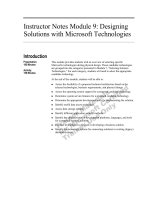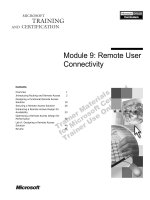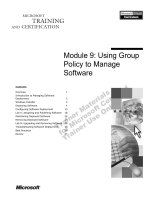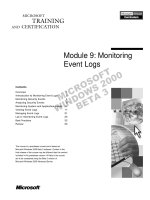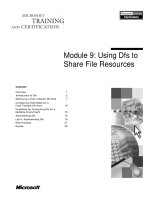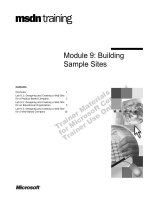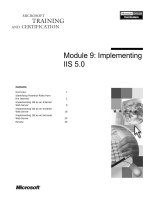CHFI module 9: Database forensics
Bạn đang xem bản rút gọn của tài liệu. Xem và tải ngay bản đầy đủ của tài liệu tại đây (9.07 MB, 60 trang )
Database Forensics
Module 09
Computer Hacking Forensic Investigator
Database Forensics
Exam 312-49
Database Forensics
Module 09
Designed by Cyber Crime Investigators. Presented by Professionals.
Copyright © by EC-Council. All Rights Reserved. Reproduction is Strictly Prohibited.
Computer Hacking Forensic Investigator v9
Module 09: Database Forensics
Exam 312-49
Module 09 Page 963
Computer Hacking Forensic Investigator Copyright © by EC-Council
All Rights Reserved. Reproduction is Strictly Prohibited.
Computer Hacking Forensic Investigator
Database Forensics
Exam 312-49
Module Objectives
After successfully completing this module, you will be able to:
1
Understand database forensics and its importance
2
Perform MSSQL forensics
3
Determine the database evidence repositories and collect the evidence files
4
Examine evidence files using SQL Server Management Studio and ApexSQL DBA
5
Perform MySQL forensics
6
Understand architecture of MySQL and determine the structure of data directory
7
List MySQL utilities for performing forensic analysis
8
Perform MySQL forensics on WordPress web application database
Copyright © by EC-Council. All Rights Reserved. Reproduction is Strictly Prohibited.
Databases store the entire data pertaining to a web application and allow users to view, access,
manage, and update the information. In some cases, either the databases or the web
applications may contain vulnerabilities that allow attackers to manipulate the contents of the
database. Therefore, a forensic investigator must have sound knowledge of the database
servers, and their file systems. Additionally, the investigator should be able to examine their
respective log files and find the cause of the attacks. This module discusses the file systems of
MSSQL and MySQL servers. Furthermore, it explains the usage of various tools to examine the
log files and find the fraudulent transactions.
Module 09 Page 964
Computer Hacking Forensic Investigator Copyright © by EC-Council
All Rights Reserved. Reproduction is Strictly Prohibited.
Computer Hacking Forensic Investigator
Database Forensics
Exam 312-49
Database Forensics and Its
Importance
Database Forensics is the examination of the databases and related metadata in a
forensically precise manner to make the findings presentable in the court of law
Forensics examination of the databases might allow a forensic investigator to:
Examine the MAC attributes of tables that could verify the actions of the attacker
Determine transactions occurred within a database system or application that
indicate evidence of fraudulent activities
Recover the deleted rows
Retrace the DDL and DML operations performed by the attacker
Copyright © by EC-Council. All Rights Reserved. Reproduction is Strictly Prohibited.
Currently, the majority of the applications use high-performance databases to manage the
data. While, the organizations are implementing robust security mechanisms to protect the
databases, hackers are introducing sophisticated ways to attack them, resulting in sensitive
data exposure.
Database forensics deals with the examination of databases and its associated metadata. The
process involved in database forensics is similar to the ones followed in computer forensics.
Databases act as the primary source of electronic evidence for every organization irrespective
of its size and complexity. On the occurrence of an unexpected incident, a forensic examiner
produces this evidence in the court of law, regardless the size of the databases. As a part of an
investigation, the investigator may examine the time stamps to check and validate the activities
carried out by the user/users on the database contents. They can also analyze the transactions
in the Transaction Log Data Files (.ldf) to see if any user/users performed fraudulent activities
on the database. A server hosting databases may contain cached information in its RAM.
Forensic investigators may even examine this information using live analysis techniques.
Module 09 Page 965
Computer Hacking Forensic Investigator Copyright © by EC-Council
All Rights Reserved. Reproduction is Strictly Prohibited.
Computer Hacking Forensic Investigator
Database Forensics
Exam 312-49
MSSQL Forensics
Copyright © by EC-Council. All Rights Reserved. Reproduction is Strictly Prohibited.
SQL server is a Relational Database Management System and is being widely adopted by
various organizations to store data associated with the applications. This includes sensitive data
related to the web application and users’ accounts in the web application. MSSQL forensics take
action when a security incident has occurred and detection and analysis of the malicious
activities performed by criminals over the SQL database file are required. A forensic investigator
needs to examine the Primary Database Files and Transaction Log Files for investigation
purpose.
Module 09 Page 966
Computer Hacking Forensic Investigator Copyright © by EC-Council
All Rights Reserved. Reproduction is Strictly Prohibited.
Computer Hacking Forensic Investigator
Database Forensics
Exam 312-49
Data Storage in SQL Server
SQL Server stores data and logs in Primary Data Files
(MDF), Secondary Data Files (NDF) and Transaction Log
Data Files (LDF), respectively.
Microsoft SQL Server Data Page
MDF are the starting point of a database and stores
user data and database objects
Page Header
NDF are optional and spread data across multiple
databases
Data Row 1
Data Row 2
LDF store log related information, which could be
useful in recovering databases. These are divided into
smaller parts called virtual log files
Data Row 3
These files are put together to form a database
Each data file (excluding log files) contains multiple
data pages (basic storage units with 8 Kb of storage)
Free Space
3
Data pages are divided into:
2 1
Row Offsets
Page Header – Presents the page ID, page type, etc.
Data Rows – Store the actual data
Offset Table – Points to the location of actual data
Copyright © by EC-Council. All Rights Reserved. Reproduction is Strictly Prohibited.
Data and Logs in SQL servers are stored in three different files:
Primary Data Files (MDF)
The primary data file is the starting point of a database and points to other files in the
database. Every database has a primary data file. The primary data file stores all the
data in the database objects (tables, schema, indexes, etc.). The file name extension for
primary data files is .mdf.
Secondary Data Files (NDF)
The secondary data files are optional. While a database contains only one primary data
file, it can contain zero/single/multiple secondary data files. The Secondary data file can
be stored on a hard disk, separate than the primary data file. The file name extension
for secondary data files is .ndf.
Transaction LOG Data Files (LDF)
The transaction log files hold the entire log information associated with the database.
The transaction log file helps a forensic investigator to examine the transactions
occurred on a database, and even recover data deleted from the database. The file
name extension for transaction log date files is .ldf and each file is divided into virtual
log files.
These three files together constitute a database, and each data file contains multiple data
pages, as discussed above.
Module 09 Page 967
Computer Hacking Forensic Investigator Copyright © by EC-Council
All Rights Reserved. Reproduction is Strictly Prohibited.
Computer Hacking Forensic Investigator
Database Forensics
Exam 312-49
Database Evidence Repositories
SQL server data is stored natively within SQL Server, and externally within windows machine hosting
the server. The main sources of evidence for an examiner would be:
SQL Server
Windows Operating System (OS)
Volatile database
Windows logs
Primary data file and Active
Transaction Logs
SQL Server Trace Files
Database plan cache
SQL Server Error
Note: System event logs, SQL Server trace files and SQL Server error logs constitute non volatile data.
Copyright © by EC-Council. All Rights Reserved. Reproduction is Strictly Prohibited.
Sources that provide the valuable information are at times overlooked by the investigators. For
instance, in intellectual property cases, databases containing finance related data are the prime
targets for attackers to damage databases. In such case, source code repositories, knowledge
management systems, and document management systems may provide better insights to the
investigator to a suspected breach. Thus, investigators will be able to help the defendants
against invalid obligations.
The databases can be used for versioning and reviewing the document lifecycle. The extended
metadata, like descriptions, keywords and comments may provide insights into the document’s
purpose. It discloses the information like who accessed and exposed the information and,
where and when it was routed.
Location of Files to Restore the Evidence
Along with the Volatile database data, Windows logs and Database plan cache, investigators
can examine the following files to have an insight of the activities occurred on the database:
Database & logs files: \\Microsoft SQL Server\MSSQL11.MSSQLSERVER\MSSQL\
DATA\*.MDF | *.LDF
Trace files: \\Microsoft SQL Server\MSSQL11.MSSQLSERVER \MSSQL\ LOG\LOG_#.TRC
SQL Server error logs: \\Microsoft SQL Server\MSSQL11.MSSQLSERVER\MSSQL\
LOG\ERRORLOG
Module 09 Page 968
Computer Hacking Forensic Investigator Copyright © by EC-Council
All Rights Reserved. Reproduction is Strictly Prohibited.
Computer Hacking Forensic Investigator
Database Forensics
Exam 312-49
Collecting Volatile Database Data
Gather volatile database information such as users’ login sessions, user transactions, etc.
Use ApexSQL DBA’s ApexSQL audit application to track the login history
Copyright © by EC-Council. All Rights Reserved. Reproduction is Strictly Prohibited.
Volatile Database is a RAM-style memory, which usually loses all its contents on power cuts.
Investigators can track the volatile database information like login sessions of an account and
the transactions using ApexSQL DBA’s ApexSQL Audit application.
By clicking on “Logon Activity history” in ApexSQL Audit application, the investigator can view
the login history for a given date and time, as shown above.
Module 09 Page 969
Computer Hacking Forensic Investigator Copyright © by EC-Council
All Rights Reserved. Reproduction is Strictly Prohibited.
Computer Hacking Forensic Investigator
Database Forensics
Exam 312-49
Collecting Primary Data File and Active
Transaction Logs Using SQLCMD
Load command line tool and establish logging
Connect to a server with the command sqlcmd -S WIN-CQQMK62867E -e -s"," -E (WINCQQMK62867E is the server used for this demonstration)
Issue :out E:\ForensicTest.txt to create a text file named “ForensicTest” and log the output of
the gathered data to E:\
Copyright © by EC-Council. All Rights Reserved. Reproduction is Strictly Prohibited.
The primary data file (mdf) and active transaction logs (ldf) play a key role in the forensic
investigation. These files offer sufficient information to a forensic examiner for dealing with the
investigation. A forensic examiner needs to know the location of mdf and ldf associated with a
database, before proceeding with the investigation. The SQLCMD application helps an
investigator to obtain the location of these files.
The SQLCMD application lets investigators load and establish a connection with the server.
To initialize connection with the server (WIN-CQQMK62867E), the following command is used
in the application
sqlcmd -S WIN-CQQMK62867E -e -s"," –E
-e is used to echo input
-s is used for column separation
-E is used for trusted connection
The above command infers that we want to establish a trusted connection with the server WINCQQMK62867E and output the results of the forthcoming commands with the columns in the
output separated by commas (,).
The following is to be issued in SQLCMD to create a new text file with name ForensicTest and
save the output to E drive:
:out E:\ForensicTest.txt
Module 09 Page 970
Computer Hacking Forensic Investigator Copyright © by EC-Council
All Rights Reserved. Reproduction is Strictly Prohibited.
Computer Hacking Forensic Investigator
Database Forensics
Exam 312-49
Collecting Primary Data File and Active
Transaction Logs Using SQLCMD (Cont’d)
Collect the active transaction log
Issue the commands sp_helpdb moviescope and go to determine the locations of the transaction log files
associated with moviescope database
The result will be recorded in E:\ drive in the respective file (ForensicTest.txt) as shown in the following
screenshot:
Copyright © by EC-Council. All Rights Reserved. Reproduction is Strictly Prohibited.
The sp_helpdb command outputs the information related to the specified database. A forensic
investigator can use this command to determine the location of the primary data file and
transaction log file that is associated with a database.
Module 09 Page 971
Computer Hacking Forensic Investigator Copyright © by EC-Council
All Rights Reserved. Reproduction is Strictly Prohibited.
Computer Hacking Forensic Investigator
Database Forensics
Exam 312-49
Collecting Primary Data File and Active
Transaction Logs Using SQLCMD (Cont’d)
Collect the active transaction log (Cont’d)
Issue the commands dbcc loginfo and go to gather the VLF allocations for the moviescope database
The result will be recorded in the respective file as shown in the following screenshot:
The status field displays the
status of the file, where “2”
represents an active file,
while “0” represents a
recoverable or unused file
Copyright © by EC-Council. All Rights Reserved. Reproduction is Strictly Prohibited.
Transaction Log Files store log related information, which could be useful in recovering
databases. It is divided into smaller parts called virtual log files.
The moviescope database files are stored in the VLF allocations. These allocations can be traced
using the following commands in SQLCMD application.
Module 09 Page 972
Computer Hacking Forensic Investigator Copyright © by EC-Council
All Rights Reserved. Reproduction is Strictly Prohibited.
Computer Hacking Forensic Investigator
Database Forensics
Exam 312-49
Collecting Primary Data File and
Transaction Logs
Collect the database files (.mdf) and log files (.ldf) from C:\Program Files\Microsoft SQL Server\MSSQL11.MSSQLSERVER
\MSSQL\DATA
These files contain complete data (in .mdf files) and logs (in .ldf files) pertaining to the databases
Copyright © by EC-Council. All Rights Reserved. Reproduction is Strictly Prohibited.
Module 09 Page 973
Computer Hacking Forensic Investigator Copyright © by EC-Council
All Rights Reserved. Reproduction is Strictly Prohibited.
Computer Hacking Forensic Investigator
Database Forensics
Exam 312-49
Collecting Active Transaction Logs Using
SQL Server Management Studio
The fn_dblog() function allows to
retrieve the active portion of the
transaction log file
fn_dblog () function filter
transactions by:
Target database object
Specific columns
SPID and/or date/time range
Issuing the query Select * from
::fn_dblog(NULL, NULL) displays the
active portion of the transaction
log file as shown in the
screenshot
Assigning NULL values imply that
the start and end points for log
sequence numbers (LSNs) are not
specified
Copyright © by EC-Council. All Rights Reserved. Reproduction is Strictly Prohibited.
As we know that the transaction logs store all the DML operations, along with some of the DDL
operations, a forensic investigator can examine these transaction logs to see the transactions
performed on the databases. However, since the logs are not in human readable format, it will
be difficult for anyone without the knowledge of SQL to examine the log records.
Forensic investigators use undocumented functions like fn_dblog () and fn_dump_dblog () to
view the transaction logs.
The function fn_dblog() accepts two parameters
The starting Log Sequence Number(LSN) or NULL(returs everything from the start of the
log)
The ending Log Sequence Number(LSN) or NULL(returs everything to the end of the log)
Note: This function should not run against an active database instance.
Module 09 Page 974
Computer Hacking Forensic Investigator Copyright © by EC-Council
All Rights Reserved. Reproduction is Strictly Prohibited.
Computer Hacking Forensic Investigator
Database Forensics
Exam 312-49
Collecting Active Transaction Logs Using
SQL Server Management Studio (Cont’d)
DBCC LOG
The DBCC LOG command allows to retrieve the
active transaction log files for the specified
database.
Syntax: DBCC LOG(<databasename >,
<output >)
The output parameter specifies the level of
information a forensic examiner wants to
retrieve
0= minimal information of each operation
such as the Current LSN, Operation,
Transaction ID, etc.
1 = slightly more info than 0, such as Flag
Bits, Previous LSN, etc.
2 = detailed information, including
(AllocUnitId, page id, slot id, etc.)
3 = full information about each operation
4 = full information on each operation along
with the hex dump of current transaction
row
Issue the query DBCC LOG(moviescope, 3)
to view the transaction log file for moviescope
database, with the detailed information for
each operation.
Copyright © by EC-Council. All Rights Reserved. Reproduction is Strictly Prohibited.
Database Consistency Checker (DBCC) commands may give the investigator valuable insight into
what is happening within the Server system. The DBCC LOG command allows investigators to
view and retrieve the active transaction log files for a specific database. Following are the other
DBCC commands that allow the investigator to obtain additional information related to the
specified database.
DBCC DBTABLE: Returns the structure of the selected database table
DBCC DBINFO: Returns information related to the database metadata
DBCC PROCBUF: Returns the contents of the SQL Server Procedure Buffer. The buffer
contains SQL Server cached executable statements such as stored procedures and SQL
queries.
DBCC BUFFER: Returns the buffer headers and pages from SQL Server's buffer cache,
where SQL Server stores results.
DBCC SHOWFILESTATS: Returns information related to the space occupied by the data
files in the active database.
DBCC PAGE: Returns the data page structure of the selected database
Module 09 Page 975
Computer Hacking Forensic Investigator Copyright © by EC-Council
All Rights Reserved. Reproduction is Strictly Prohibited.
Computer Hacking Forensic Investigator
Database Forensics
Exam 312-49
Collecting Database Plan Cache
Issue the syntax select * from sys.dm_exec_cached_plans cross apply sys.dm_exec_sql_text (plan_handle) to
retrieve SQL text of all cached entries
The plan_handle argument retrieves the compiled query plans from the SQLCP or the OBJCP cache stores
Copyright © by EC-Council. All Rights Reserved. Reproduction is Strictly Prohibited.
To collect database plan cache, the following query is used in the application:
select * from sys.dm_exec_cached_plans cross apply
sys.dm_exec_sql_text(plan_handle)
Issuing sys.dm_exec_cached_plans in the syntax returns a row for each query plan that the
SQL server had cached to speed up the query execution. This dynamic management view will
help users to find cached query plans, cached query text, the amount of memory taken by
cached plans, and the reuse count of the cached plans.
The command retrieves the SQL text of all cached entries. Note that the plan_handle
argument in the syntax uniquely identifies a query plan for a batch that server had cached or is
currently executing.
Module 09 Page 976
Computer Hacking Forensic Investigator Copyright © by EC-Council
All Rights Reserved. Reproduction is Strictly Prohibited.
Computer Hacking Forensic Investigator
Database Forensics
Exam 312-49
Collecting Database Plan Cache
(Cont’d)
Collect additional plan cache specifics
Issue the syntax select * from sys.dm_exec_query_stats to view the aggregate performance statistics for cached
query plans. It displays only one row per query statement
Copyright © by EC-Council. All Rights Reserved. Reproduction is Strictly Prohibited.
To collect additional plan cache specifics from the database, like viewing the aggregate
performance statistics, the following query is used.
select * from sys.dm_exec_query_stats
The result contains one row per query statement within the cached plan, and the lifetime of the
rows is tied to the plan itself. When a plan is removed from the cache, the corresponding rows
are eliminated from this view.
Module 09 Page 977
Computer Hacking Forensic Investigator Copyright © by EC-Council
All Rights Reserved. Reproduction is Strictly Prohibited.
Computer Hacking Forensic Investigator
Database Forensics
Exam 312-49
Collecting Database Plan Cache
(Cont’d)
Collect additional plan cache specifics
Issue the syntax select * from sys.dm_exec_cached_plans cross apply sys.dm_exec_plan_attributes(plan_handle)
to view one row per plan attribute for the plan specified by the plan handle
Copyright © by EC-Council. All Rights Reserved. Reproduction is Strictly Prohibited.
To view one row per plan attribute for the plan specified by the plan handle, the following
query is used.
select
*
from
sys.dm_exec_cached_plans
sys.dm_exec_plan_attributes(plan_handle)
cross
apply
It is to be noted that plan_handle in the syntax uniquely identifies a query plan for a batch that
has executed and whose plan resides in the plan cache.
Module 09 Page 978
Computer Hacking Forensic Investigator Copyright © by EC-Council
All Rights Reserved. Reproduction is Strictly Prohibited.
Computer Hacking Forensic Investigator
Database Forensics
Exam 312-49
Collecting Windows Logs
Windows Logs store the logon events performed on the SQL Server. Launch Event
Viewer, expand Windows Logs node and view various Windows event logs
Copyright © by EC-Council. All Rights Reserved. Reproduction is Strictly Prohibited.
Windows event logs are simple text files in XML format (EVTX) used by Windows Vista and later
versions. Windows holds different types of logs including Administrative, Operational, Analytic,
Debug, application, etc.
The Event Viewer in the Windows operating system (OS) allows the user to view the event logs
on a local or a remote machine. Launch Event Viewer, expand Windows Logs node and select
the type of logs (i.e., logs pertaining to the Application, Security, Setup, System, or Forwarded
Events) need to be viewed.
In the forensic point of view, the event log files play a vital role, as these event logs track all the
“significant events” on any computer. Any program that runs on the computer posts a
notification in the event log, and simultaneously posts a notification before it ends. Events
which include system access, operating system jerk, driver or any hardware issue, etc., are
saved in the event logs. Investigators can use this data to trace out the attackers.
Module 09 Page 979
Computer Hacking Forensic Investigator Copyright © by EC-Council
All Rights Reserved. Reproduction is Strictly Prohibited.
Computer Hacking Forensic Investigator
Database Forensics
Exam 312-49
Collecting SQL Server Trace Files
To collect the trace files (.trc) navigate to C:\Program Files\Microsoft SQL
Server\MSSQL11.MSSQLSERVER\MSSQL\LOG
The trace files contain the events occurred on a SQL server and the host databases
Copyright © by EC-Council. All Rights Reserved. Reproduction is Strictly Prohibited.
Collecting SQL Server Error Logs
To collect the SQL Server error logs navigate to C:\Program Files\Microsoft SQL
Server\MSSQL11.MSSQLSERVER\MSSQL\LOG
The SQL Server error logs contain user defined events and specific system events
Copyright © by EC-Council. All Rights Reserved. Reproduction is Strictly Prohibited.
Module 09 Page 980
Computer Hacking Forensic Investigator Copyright © by EC-Council
All Rights Reserved. Reproduction is Strictly Prohibited.
Computer Hacking Forensic Investigator
Database Forensics
Exam 312-49
As discussed above, Trace files record all the events occurred on the SQL Server and databases
present in it, while SQL Server error logs record user-defined events and specific system events.
The error logs also contain the IP Address of SQL Server client connections. A new error log file
is created every time a new SQL Server instance occurs.
Forensic investigators may use SQL Server Profiler to view the trace files, and SQL Server
Management Studio or any text editor to view the error logs. Both the files act as a very
important evidence for the forensic examiner while conducting an investigation on the SQL
Server.
Module 09 Page 981
Computer Hacking Forensic Investigator Copyright © by EC-Council
All Rights Reserved. Reproduction is Strictly Prohibited.
Computer Hacking Forensic Investigator
Database Forensics
Exam 312-49
Database Forensics Using SQL
Server Management Studio
Step 1: Examine Windows Logs
Examine the Windows Logs to obtain information related to SQL Server authentication, startup
and shutdown instances, and the IP addresses of client connections
It is observed that an event associated with the server login and pertaining to MSSQL Server is recorded. Now, the error
log need to be examined to find out any successful login event.
Copyright © by EC-Council. All Rights Reserved. Reproduction is Strictly Prohibited.
Database Forensics Using SQL
Server Management Studio (Cont’d)
Step 2: Examine Error Logs
Navigate to C:\Program Files\Microsoft SQL Server\MSSQL11.MSSQLSERVER\MSSQL\LOG and open
ERRORLOG file with Notepad
Examine the log file to see the record of user defined events (such as user logins)
Here, it is evident that there is a successful login instance recorded on the name of a user sa. Now, the trace
file can be viewed to examine the SQL Server based events associated with this user.
Copyright © by EC-Council. All Rights Reserved. Reproduction is Strictly Prohibited.
Module 09 Page 982
Computer Hacking Forensic Investigator Copyright © by EC-Council
All Rights Reserved. Reproduction is Strictly Prohibited.
Computer Hacking Forensic Investigator
Database Forensics
Exam 312-49
Database Forensics Using SQL
Server Management Studio (Cont’d)
Step 3: Examine Trace Files
Navigate to C:\Program Files\Microsoft SQL Server\MSSQL.1\MSSQL\LOG and double-click log_n.trc file
(where n is the last number in the sequence). The trace file opens in a SQL Server Profiler
Examine the file to identify any suspicious activity
By examining the file, some user based events observed on moviescope database. Make a note of the SPID
and the start time of the instance.
Copyright © by EC-Council. All Rights Reserved. Reproduction is Strictly Prohibited.
Database Forensics Using SQL
Server Management Studio (Cont’d)
Step 4: Examine Active Transaction Logs
Launch SQL Server Management Studio and connect to the SQL Server. Execute the command dbcc log(moviescope, 3)
in the query window to view the transaction log file for moviescope database, with detailed information for each
operation. Here, an event can be observed (SPID: 56 and Transaction ID: 0000:000007c9) with a modified row.
1 - Indicates the beginning of a transaction
2 - Indicates the type of the transaction
performed
3 - Indicates the end of a transaction
4 - SPID: Indicate the current user process ID
5 - Unique transaction identifier
6 - Data Page Identifier for rows containing
the updated record
7 - On data page row location of record
8 - In row data offset of modification
9 - Value of the row before modification
10 - Value of the row after modification
Convert hexadecimal value of the page ID to decimal, and locate the page containing the updated record. Here, the calculated decimal
value of the page ID is 154. (0000009a)16 = (154)10
Copyright © by EC-Council. All Rights Reserved. Reproduction is Strictly Prohibited.
Module 09 Page 983
Computer Hacking Forensic Investigator Copyright © by EC-Council
All Rights Reserved. Reproduction is Strictly Prohibited.
Computer Hacking Forensic Investigator
Database Forensics
Exam 312-49
Database Forensics Using SQL
Server Management Studio (Cont’d)
Step 5: Examine Data Page
Now, we inspect the modified data pages to find the object ID where the data has been modified
Execute the commands: dbcc traceon(3604)dbcc page(moviescope,1,154,1) to view the 154th data page on the
query window
The PAGE HEADER contains information regarding the data page such as the type of page, partition ID, object ID,
etc. Note down the Object ID
Copyright © by EC-Council. All Rights Reserved. Reproduction is Strictly Prohibited.
Database Forensics Using SQL
Server Management Studio (Cont’d)
Step 6: View the Object
Next, we use the object ID to find the name of the object/table in moviescope database, whose data was
modified
Execute the command Select * from sysobjects where id = 21575115
The object User_Profile has been modified. Next, we use the same object ID to gather the object schema
Copyright © by EC-Council. All Rights Reserved. Reproduction is Strictly Prohibited.
Module 09 Page 984
Computer Hacking Forensic Investigator Copyright © by EC-Council
All Rights Reserved. Reproduction is Strictly Prohibited.
Computer Hacking Forensic Investigator
Database Forensics
Exam 312-49
Database Forensics Using SQL
Server Management Studio (Cont’d)
Step 7: Gather the Object Schema
Next, using the object ID, the object schema (table) associated with the User_Profile object is collected
Execute the command: SELECT sc.colorder , sc.name, st.name as 'datatype', sc.length FROM syscolumns sc,
systypes st WHERE sc.xusertype = st.xusertype and sc.id = 21575115 ORDER BY colorder
By issuing the above command, the object schema is obtained. One of the entries in the table is subjected to
modification
Copyright © by EC-Council. All Rights Reserved. Reproduction is Strictly Prohibited.
Database Forensics Using SQL
Server Management Studio (Cont’d)
Step 8: View the Modified Record
As we have seen in step 4, the page ID is 154 and slot ID is 4. Therefore, issue the commands
dbcc trace (3604)
dbcc page(moviescope,1,154,1)
To view the data page 154. Scroll down to Slot no. 4 (data row no. 4)
Copyright © by EC-Council. All Rights Reserved. Reproduction is Strictly Prohibited.
Module 09 Page 985
Computer Hacking Forensic Investigator Copyright © by EC-Council
All Rights Reserved. Reproduction is Strictly Prohibited.
Computer Hacking Forensic Investigator
Database Forensics
Exam 312-49
Database Forensics Using SQL
Server Management Studio (Cont’d)
Step 9: Identify the Data Type
Using slot ID 4 and row offset 8, which were obtained previously from the transaction log, the specific
point within the data row was identified in which the transaction began
Using the table schema obtained earlier, the data type within this row offset is the age column which contains a 4-byte int data type.
Copyright © by EC-Council. All Rights Reserved. Reproduction is Strictly Prohibited.
Database Forensics Using SQL
Server Management Studio (Cont’d)
Step 10: Compare the Row Logs
Note down the hex values of RowLog Contents 0 and RowLog Contents 1 and convert them to their
equivalent decimal values
Thus, it is evident that the age entity has tampered from 25 to 200, which was successfully determined
using forensic investigation
RowLog Contents 0
RowLog Contents 1
0x19
0xc8
Decimal Value
Decimal Value
25
200
Copyright © by EC-Council. All Rights Reserved. Reproduction is Strictly Prohibited.
Module 09 Page 986
Computer Hacking Forensic Investigator Copyright © by EC-Council
All Rights Reserved. Reproduction is Strictly Prohibited.
